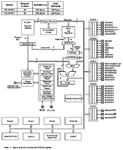#MAAM#
Full Member level 2
Hi,
I'm confused:?: about some information in saving program and data in micro-controller pic16f877
1) Program in flash program memory.
2) Local variables in RAM.
3) Global variable in EEPROM.
this my understanding ....... it's true or false ?:grin:
I'm confused:?: about some information in saving program and data in micro-controller pic16f877
1) Program in flash program memory.
2) Local variables in RAM.
3) Global variable in EEPROM.
this my understanding ....... it's true or false ?:grin:
